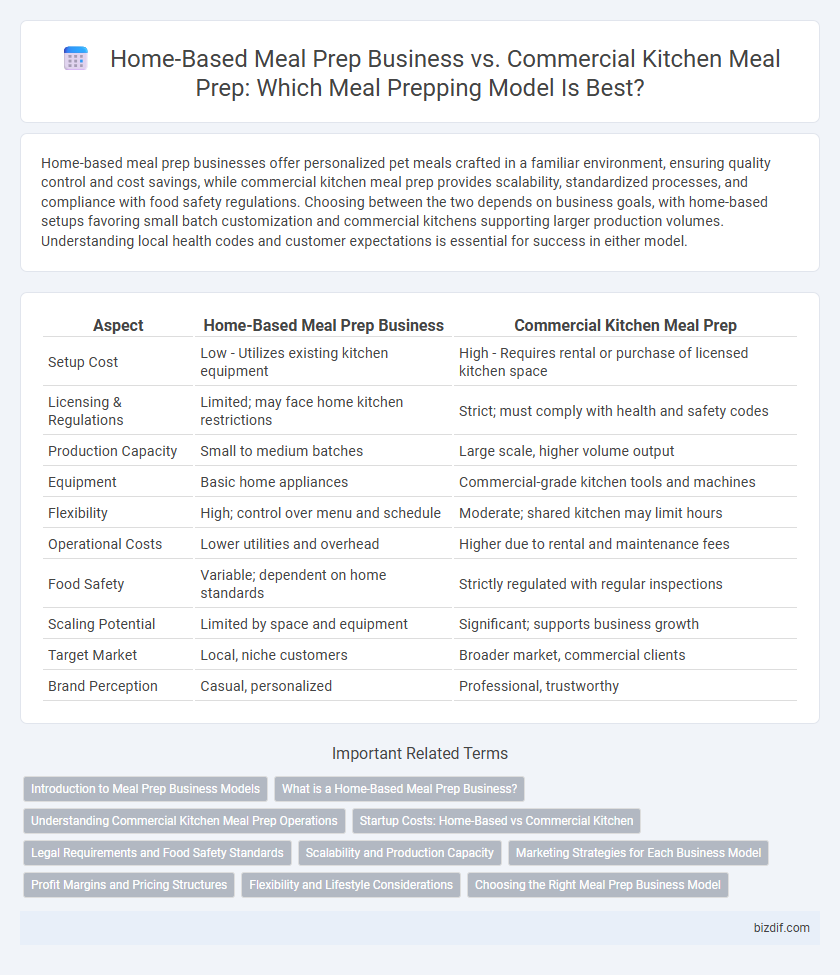Home-based meal prep businesses offer personalized pet meals crafted in a familiar environment, ensuring quality control and cost savings, while commercial kitchen meal prep provides scalability, standardized processes, and compliance with food safety regulations. Choosing between the two depends on business goals, with home-based setups favoring small batch customization and commercial kitchens supporting larger production volumes. Understanding local health codes and customer expectations is essential for success in either model.
Table of Comparison
| Aspect | Home-Based Meal Prep Business | Commercial Kitchen Meal Prep |
|---|---|---|
| Setup Cost | Low - Utilizes existing kitchen equipment | High - Requires rental or purchase of licensed kitchen space |
| Licensing & Regulations | Limited; may face home kitchen restrictions | Strict; must comply with health and safety codes |
| Production Capacity | Small to medium batches | Large scale, higher volume output |
| Equipment | Basic home appliances | Commercial-grade kitchen tools and machines |
| Flexibility | High; control over menu and schedule | Moderate; shared kitchen may limit hours |
| Operational Costs | Lower utilities and overhead | Higher due to rental and maintenance fees |
| Food Safety | Variable; dependent on home standards | Strictly regulated with regular inspections |
| Scaling Potential | Limited by space and equipment | Significant; supports business growth |
| Target Market | Local, niche customers | Broader market, commercial clients |
| Brand Perception | Casual, personalized | Professional, trustworthy |
Introduction to Meal Prep Business Models
Home-based meal prep businesses offer lower startup costs, flexible scheduling, and the ability to test recipes with a local clientele, making them ideal for entrepreneurs seeking minimal overhead. Commercial kitchen meal prep models provide access to professional-grade equipment, larger production capacity, and compliance with health regulations, enabling scalability and distribution to broader markets. Choosing between these models depends on factors such as target customer base, production volume, and investment in kitchen infrastructure.
What is a Home-Based Meal Prep Business?
A home-based meal prep business operates from a personal kitchen, allowing entrepreneurs to prepare and package meals on a smaller, more flexible scale. This model reduces overhead costs by eliminating the need for commercial kitchen rental fees while maintaining control over ingredient sourcing and recipe customization. Compliance with local health regulations and food safety standards remains crucial to ensure product quality and customer trust.
Understanding Commercial Kitchen Meal Prep Operations
Commercial kitchen meal prep operations involve using licensed, inspected facilities designed for large-scale food preparation, ensuring compliance with health and safety regulations. These kitchens offer access to industrial-grade equipment, ample storage, and consistent sanitation standards, facilitating efficient workflow and high-volume production. Understanding scheduling, ingredient sourcing, and waste management within a commercial kitchen is crucial for scaling a meal prep business effectively.
Startup Costs: Home-Based vs Commercial Kitchen
Starting a home-based meal prep business typically requires significantly lower startup costs, often limited to basic kitchen equipment, ingredients, and packaging materials, making it accessible for entrepreneurs with tight budgets. In contrast, launching a commercial kitchen meal prep operation demands substantial upfront investment in leased or owned commercial kitchen space, specialized equipment, permits, insurance, and compliance with health regulations, resulting in higher initial expenditures. Evaluating the balance between affordability and scalability is crucial for selecting the appropriate startup model in the meal prep industry.
Legal Requirements and Food Safety Standards
Home-based meal prep businesses must comply with local health department regulations, including food handler permits and kitchen inspections, but often face stricter limitations on equipment and space. Commercial kitchen meal prep operations typically require adherence to comprehensive food safety standards such as Hazard Analysis Critical Control Point (HACCP) protocols, commercial-grade sanitation, and zoning permits to operate legally. Both setups mandate consistent temperature controls, proper labeling, and traceability to meet regulatory food safety requirements and protect consumer health.
Scalability and Production Capacity
Home-based meal prep businesses typically face limitations in scalability due to constrained space and equipment, restricting production capacity and growth potential. Commercial kitchen meal prep operations benefit from industrial-grade appliances and larger workspaces, enabling higher volume output and streamlined processes for mass production. Leveraging commercial kitchens supports scaling by accommodating increased order quantities and diverse menu offerings with consistent quality.
Marketing Strategies for Each Business Model
Home-based meal prep businesses thrive by leveraging localized social media marketing, community engagement, and personalized customer experiences to build loyal client bases. Commercial kitchen meal prep businesses benefit from broader digital advertising campaigns, partnerships with gyms or wellness centers, and scalable branding efforts to attract larger markets. Tailoring marketing strategies to operational scale and target demographics maximizes customer acquisition and retention in each meal prep model.
Profit Margins and Pricing Structures
Home-based meal prep businesses typically incur lower overhead costs, leading to higher profit margins compared to commercial kitchen operations. Commercial kitchens demand significant expenses for rental space, utilities, and staff, which require higher pricing structures to maintain profitability. Pricing strategies in home-based setups can be more competitive, leveraging reduced fixed costs to attract price-sensitive customers while sustaining sustainable earnings.
Flexibility and Lifestyle Considerations
Running a home-based meal prep business offers unmatched flexibility, allowing entrepreneurs to set their own schedules and balance personal commitments more easily. In contrast, operating in a commercial kitchen often requires adherence to strict hours and regulations, impacting lifestyle freedom. Choosing between the two depends on prioritizing flexible work hours versus access to expanded resources and scalability.
Choosing the Right Meal Prep Business Model
Choosing the right meal prep business model hinges on evaluating factors such as startup costs, scalability, and regulatory requirements. Home-based meal prep businesses offer lower overhead and flexible scheduling but may face restrictions on health codes and limited production capacity. Commercial kitchen meal prep models enable larger-scale operations with professional-grade equipment, allowing for higher volume and compliance with commercial food safety standards.
Home-Based Meal Prep Business vs Commercial Kitchen Meal Prep Infographic

 bizdif.com
bizdif.com